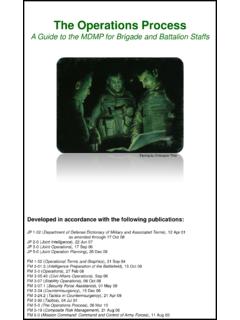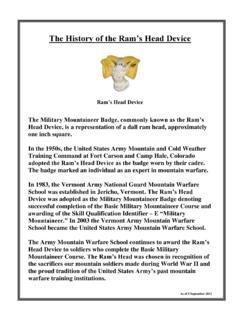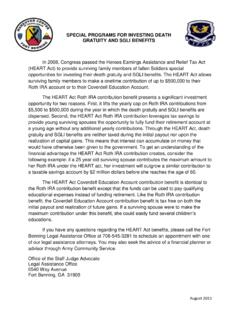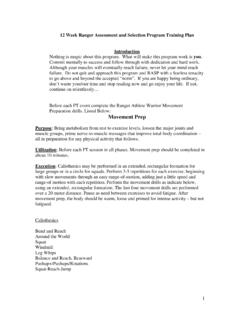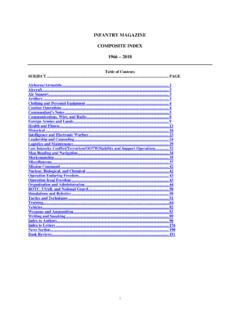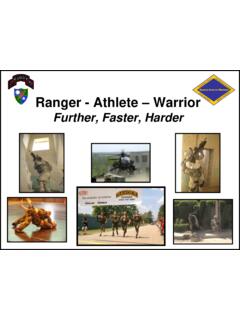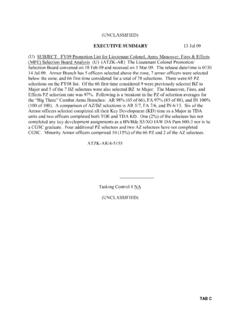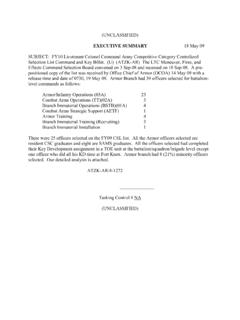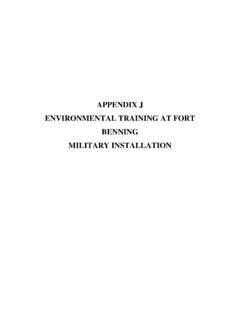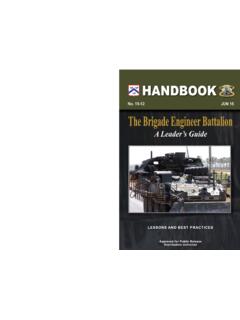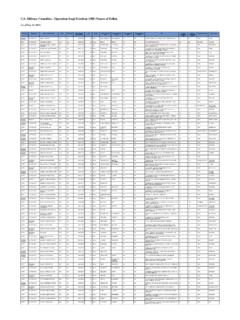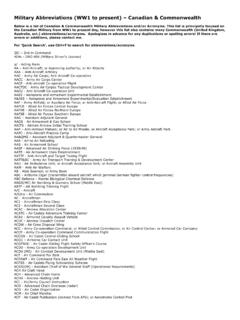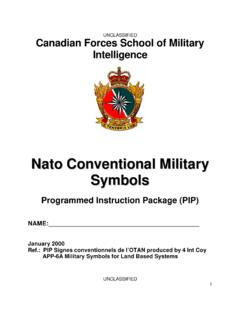Transcription of Line Understanding Reconnaissance Missions Instead of ...
1 From the Screen line Understanding Reconnaissance Missions Instead of Focusing on Reconnaissance Platforms by CPT Kyle Hoisington The world of Reconnaissance and security Missions is vague to a lot of Soldiers and leaders despite no significant changes over the years. However, the platforms scouts use to conduct their Missions vary greatly among the different brigade structures (armored brigade combat team (BCT), infantry BCT and Stryker BCT). Commanders should not look at the platform to determine a certain mission . How scouts conduct a Reconnaissance mission is not formed by their platform. The scout s mission is formed through detailed commander s Reconnaissance guidance.
2 The argument that dismounted scouts conduct different Reconnaissance Missions than tracked vehicle scouts is invalid. The platform in which scouts move about the battlefield does not have as much of an impact on their mission as the commander s Reconnaissance guidance. This article will assist in creating an Understanding of the five Reconnaissance Missions and how multiple Reconnaissance platforms are used. For purposes of this article, Reconnaissance platforms are described as types of platforms scouts use when conducting Reconnaissance Missions . Reconnaissance Missions To understand how commander s Reconnaissance guidance impacts a Reconnaissance mission more than the platform scouts use, we must have a common Understanding of the forms of Reconnaissance .
3 Army Doctrinal Reference Publication (ADRP) 3 90 identifies the five forms of Reconnaissance as route, area, zone, Reconnaissance in force and special. Route Reconnaissance is a directed effort to obtain detailed information of a specified route and all terrain from which the enemy could influence movement along the route (ADRP 3 90). Route Reconnaissance Missions can focus on either terrain or enemy template to influence a route. When focusing on the route s terrain, commanders may want to know how to move their maneuver forces from the line of departure to their objective. When focusing on the enemy that influences the route, a route Reconnaissance mission inherits more risk.
4 A commander must determine if the scouts organic capabilities are enough to reduce the risk associated with an enemy focused route Reconnaissance . Area Reconnaissance focuses on obtaining detailed information about the terrain or enemy activity within a prescribed area (ADRP 3 90). An area is commonly described graphically as a named area of interest (NAI) and can also be graphically described as a checkpoint. NAIs can encompass a large surface or a specific point. This is due to the amount of, or lack thereof, mission analysis the staff conducts in developing the area of interest. Zone Reconnaissance involves a directed effort to obtain detailed information on all routes, obstacles, terrain and enemy forces within a zone defined by boundaries (ADRP 3 90).
5 A zone Reconnaissance allows subordinate leaders to look everywhere within their boundaries for the priority intelligence requirements (PIR). This differs from area and route Reconnaissance because during a route or area Reconnaissance mission , the higher headquarters is directing the information collection asset to look at a specific area. During a zone Reconnaissance , the Understanding of the area of operations is usually more ambiguous, which requires subordinate leaders to take more initiative. Reconnaissance in force is a deliberate combat operation designed to discover or test the enemy s strength, dispositions and reactions or to obtain other information (ADRP 3 90).
6 A Reconnaissance in force is a mission that requires more protection for the scouts due to enemy direct fire contact that is required to test the enemy s reactions. A Reconnaissance in force differs from an enemy focused zone Reconnaissance for several reasons. A Reconnaissance in force is solely enemy focused, whereas a zone Reconnaissance may focus on terrain or civil based PIR. The intent of a Reconnaissance in force is to discover a weakness in the enemy s formation to allow a main body to exploit the weakness. This differs from an enemy focused zone Reconnaissance , where the intent is to determine size and location to allow the main body to conduct offensive operations.
7 Special Reconnaissance is Reconnaissance and surveillance actions conducted as a special operation in hostile, denied or politically sensitive environments to collect or verify information of strategic or operational significance employing military capabilities not normally found in conventional forces (ADRP 3 90). Special Reconnaissance will not be addressed in this article because Cavalry formations found in the BCTs do not organically conduct special Reconnaissance . Insertion methods There are multiple ways scouts use Reconnaissance platforms when conducting a Reconnaissance mission . Several of the methods include air insertion, dismounted insertion, wheeled vehicle insertion and tracked vehicle insertion.
8 All these methods of moving scouts to their Reconnaissance objective are found in ABCTs, IBCTs and SBCTs. There are major differences in mobility from one platform to the other. However, each platform is only the way scouts are moved from their line of departure to their Reconnaissance objective. The actions on the Reconnaissance objective are the same among all Reconnaissance platforms. When most people think of scouts, they first think of stealth. This is a common trend throughout the dismounted formations and even in some of the wheeled vehicle formations. Other people think of scouts as having large amounts of protection to survive first contact and are able to send reports under direct fire contact.
9 This trend is common in some of the wheeled vehicle formations but predominantly in the tracked vehicle formations. I tend to look at the different types of platforms on a scale (Figure 1). On one end of the scale is the air and dismounted method, with the wheeled vehicle method in the middle and the tracked vehicle method on the far end of the scale. Along the same scale, stealth is directly correlated with the air and dismounted method, and protection is correlated with the tracked vehicle method. I use this scale to visualize how scouts would execute any of the Reconnaissance Missions . By using this scale, there is some kind of stealth associated with wheeled vehicles, while there is some kind of protection with tracked vehicles.
10 Of course, the mission variables play a role when identifying which type of platform can best conduct a form of Reconnaissance . Given this basic analysis, it is reasonable to state that each type of platform can conduct each form of Reconnaissance as long as the scout is given more guidance on how to use his particular platform. This additional guidance is given in the form of commander s Reconnaissance guidance. Recently, the development of the 6x36 scout platoon has given more abilities in each formation to allow a combination of both stealth and protection in each of the platforms. With 18 dismounted scouts in a tracked vehicle formation, the tracked vehicle scout platoon can combine both stealth with protection based on mission variables.
